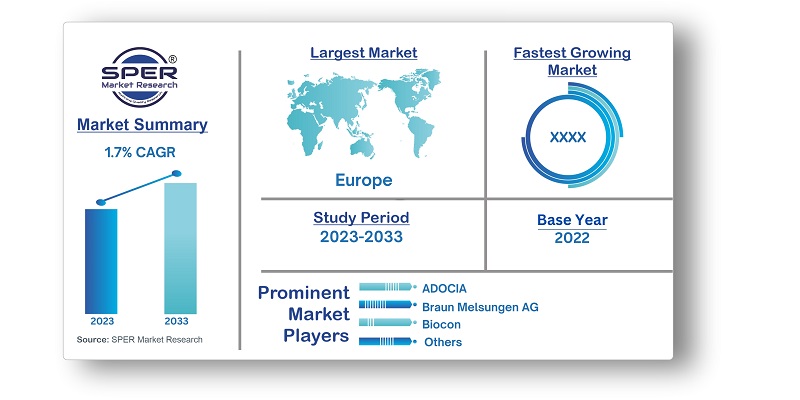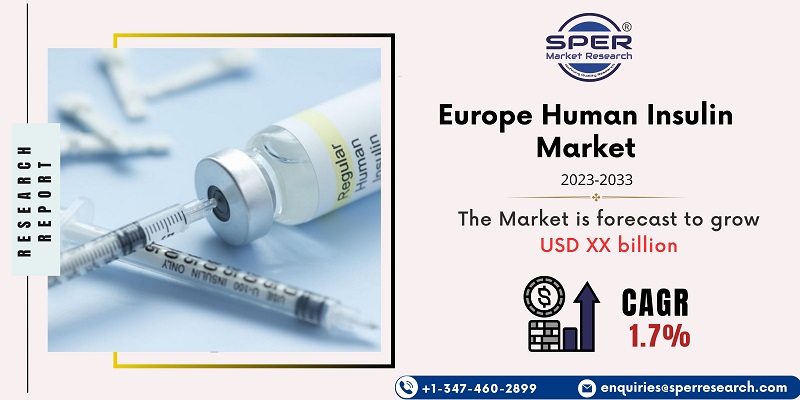
Europe Human Insulin Market Growth, Size, Trends, Share, Revenue, Challenges and Future Outlook
Europe Human Insulin Market Size- By Type, By Diabetes Type, By Distribution Channel- Regional Outlook, Competitive Strategies and Segment Forecast to 2033
| Published: Nov-2023 | Report ID: PHAR2315 | Pages: 1 - 152 | Formats*: |
| Category : Pharmaceutical | |||
- January 2023: Abbott and Sanofi collaborated to provide solutions that integrate insulin dosage data from Sanofi's diabetes care devices with FreeStyle Libre technology. People with diabetes and medical practitioners will be able to make more informed decisions about medication, diet, and lifestyle choices because to this collaboration.
- August 2022: The US FDA and the European Medicines Agency (EMA) provided extra funding to Oramed's Oralis project in order to conduct a Phase III clinical trial of Oralis, which aimed to demonstrate the oral drug's efficacy in glycaemic management in patients with type 2 diabetes.
- June 2021: In comparison to premixed insulin, Sanofi reported that the new long-acting human insulin analogue Soliqua demonstrated better blood sugar control without causing weight gain.


| Report Metric | Details |
| Market size available for years | 2019-2033 |
| Base year considered | 2022 |
| Forecast period | 2023-2033 |
| Segments covered | By Type, By Diabetes Type, By Distribution Channel |
| Regions covered | France, Germany, Italy, Scandinavia, Spain, U.K., and rest of Europe |
| Companies Covered | ADOCIA, B. Braun Melsungen AG, Biocon, BIOTON S.A., Eli Lilly and Company, Lupin, Novo Nordisk A/S, Sanofi, WOCKHARDT, Others |
- Health Insurers and Payers
- Healthcare Professionals
- People with Diabetes (PWD)
- Pharmaceutical Companies
- Pharmacists
- Public Health Organizations
- Researchers and Scientists
- Others
| By Type: |
|
| By Diabetes Type: |
|
| By Distribution Channel: |
|
- Europe Human Insulin Market Size (FY’2023-FY’2033)
- Overview of Europe Human Insulin Market
- Segmentation of Europe Human Insulin Market By Type (Analogue Insulin, Traditional Human Insulin)
- Segmentation of Europe Human Insulin Market By Diabetes Type (Diabetes 1, Diabetes 2)
- Segmentation of Europe Human Insulin Market By Distribution Channel (Hospital Pharmacies, Retail & Online Pharmacies)
- Statistical Snap of Europe Human Insulin Market
- Expansion Analysis of Europe Human Insulin Market
- Problems and Obstacles in Europe Human Insulin Market
- Competitive Landscape in the Europe Human Insulin Market
- Impact of COVID-19 and Demonetization on Europe Human Insulin Market
- Details on Current Investment in Europe Human Insulin Market
- Competitive Analysis of Europe Human Insulin Market
- Prominent Players in the Europe Human Insulin Market
- SWOT Analysis of Europe Human Insulin Market
- Europe Human Insulin Market Future Outlook and Projections (FY’2023-FY’2033)
- Recommendations from Analyst
1.1. Scope of the report1.2. Market segment analysis
2.1. Research data Source2.1.1. Secondary Data2.1.2. Primary Data2.1.3. SPER’s internal database2.1.4. Premium insight from KOL’s2.2. Market size estimation2.2.1. Top-down and Bottom-up approach2.3. Data triangulation
4.1. Driver, Restraint, Opportunity and Challenges analysis4.1.1. Drivers4.1.2. Restraints4.1.3. Opportunities4.1.4. Challenges4.2. COVID-19 Impacts of the Europe Human Insulin Market
5.1. SWOT Analysis
5.1.1. Strengths5.1.2. Weaknesses5.1.3. Opportunities5.1.4. Threats5.2. PESTEL Analysis5.2.1. Political Landscape5.2.2. Economic Landscape5.2.3. Social Landscape5.2.4. Technological Landscape5.2.5. Environmental Landscape5.2.6. Legal Landscape5.3. PORTER’s Five Forces5.3.1. Bargaining power of suppliers5.3.2. Bargaining power of buyers5.3.3. Threat of Substitute5.3.4. Threat of new entrant5.3.5. Competitive rivalry5.4. Heat Map Analysis
6.1. Europe Human Insulin Market Manufacturing Base Distribution, Sales Area, Product Type6.2. Mergers & Acquisitions, Partnerships, Product Launch, and Collaboration in Europe Human Insulin Market
7.1. Europe Human Insulin Market Value Share and Forecast, By Type, 2023-20337.2. Analogue Insulin7.2.1. Fast-acting7.2.2. Long-acting7.2.3. Premix7.3. Traditional Human Insulin7.3.1. Fast-acting7.3.2. Long-acting + Intermediate7.3.3. Premix7.3.4. Short-acting
8.1. Europe Human Insulin Market Value Share and Forecast, By Diabetes Type, 2023-20338.2. Diabetes 18.3. Diabetes 2
9.1. Europe Human Insulin Market Value Share and Forecast, By Distribution Channel, 2023-20339.2. Hospital Pharmacies9.3. Retail & Online Pharmacies
10.1. Europe Human Insulin Market Size and Market Share
11.1. Europe Human Insulin Market Size and Market Share By Type (2019-2026)11.2. Europe Human Insulin Market Size and Market Share By Type (2027-2033)
12.1. Europe Human Insulin Market Size and Market Share By Diabetes Type (2019-2026)12.2. Europe Human Insulin Market Size and Market Share By Diabetes Type (2027-2033)
13.1. Europe Human Insulin Market Size and Market Share By Distribution Channel (2019-2026)13.2. Europe Human Insulin Market Size and Market Share By Distribution Channel (2027-2033)
14.1. Europe Human Insulin Market Size and Market Share By Region (2019-2026)14.2. Europe Human Insulin Market Size and Market Share By Region (2027-2033)14.3. France14.4. Germany14.5. Italy14.6. Scandinavia14.7. Spain14.8. U.K.14.9. Rest of Europe
15.1. ADOCIA15.1.1. Company details15.1.2. Financial outlook15.1.3. Product summary15.1.4. Recent developments15.2. B. Braun Melsungen AG15.2.1. Company details15.2.2. Financial outlook15.2.3. Product summary15.2.4. Recent developments15.3. Biocon15.3.1. Company details15.3.2. Financial outlook15.3.3. Product summary15.3.4. Recent developments15.4. BIOTON S.A.15.4.1. Company details15.4.2. Financial outlook15.4.3. Product summary15.4.4. Recent developments15.5. Eli Lilly and Company15.5.1. Company details15.5.2. Financial outlook15.5.3. Product summary15.5.4. Recent developments15.6. Lupin15.6.1. Company details15.6.2. Financial outlook15.6.3. Product summary15.6.4. Recent developments15.7. Novo Nordisk A/S15.7.1. Company details15.7.2. Financial outlook15.7.3. Product summary15.7.4. Recent developments15.8. Sanofi15.8.1. Company details15.8.2. Financial outlook15.8.3. Product summary15.8.4. Recent developments15.9. WOCKHARDT15.9.1. Company details15.9.2. Financial outlook15.9.3. Product summary15.9.4. Recent developments15.10. Others
SPER Market Research’s methodology uses great emphasis on primary research to ensure that the market intelligence insights are up to date, reliable and accurate. Primary interviews are done with players involved in each phase of a supply chain to analyze the market forecasting. The secondary research method is used to help you fully understand how the future markets and the spending patterns look likes.
The report is based on in-depth qualitative and quantitative analysis of the Product Market. The quantitative analysis involves the application of various projection and sampling techniques. The qualitative analysis involves primary interviews, surveys, and vendor briefings. The data gathered as a result of these processes are validated through experts opinion. Our research methodology entails an ideal mixture of primary and secondary initiatives.



Frequently Asked Questions About This Report
PLACE AN ORDER
Year End Discount
Sample Report
Pre-Purchase Inquiry
NEED CUSTOMIZATION?
Request CustomizationCALL OR EMAIL US
100% Secure Payment






Related Reports
Our Global Clients
Our data-driven insights have influenced the strategy of 200+ reputed companies across the globe.






















